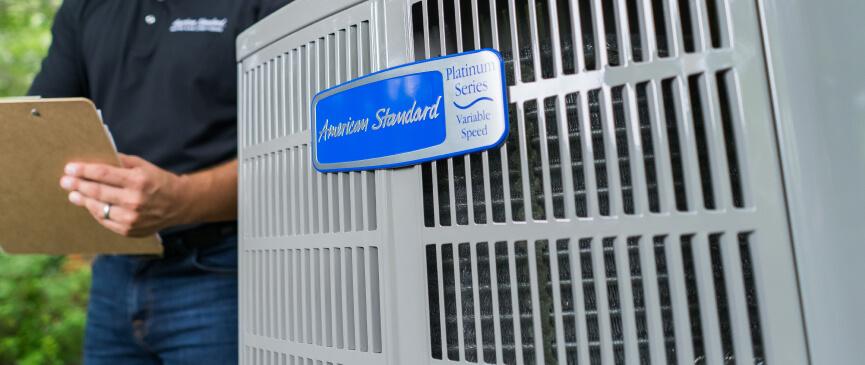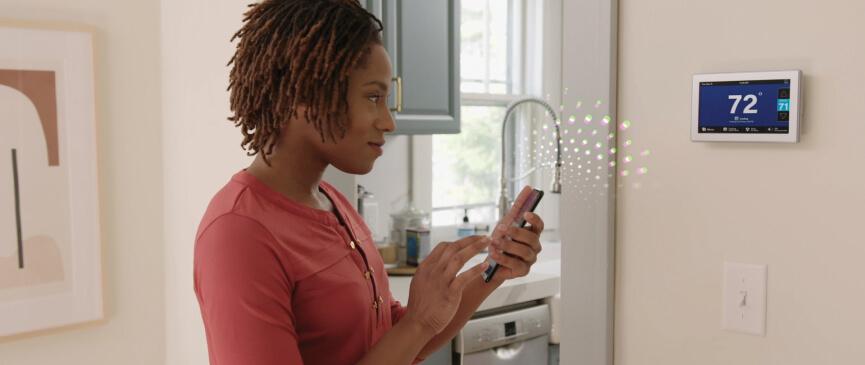What Size AC Unit Do I Need?
Just like Goldilocks, your air conditioner can’t be too big or too small.

Investing in the right HVAC unit for your home is more than choosing a quality brand and warranty. One of the first questions you should ask an American Standard Customer Care dealer is, “What size HVAC do I need?”. Understanding how the size of an air conditioner (AC) will affect your home’s comfort will help illustrate why bigger isn’t always better in the HVAC world.
Why HVAC size matters
The right size air conditioner for your home will work much more efficiently. When your system is too large or too small, you may battle an uncomfortable indoor climate and higher energy costs.
Air conditioner (AC) too small
Purchasing an AC that’s too small for your home means the unit runs constantly and the indoor temperature is rarely cool enough. It’s also possible you could experience uneven cooling throughout your home.
Air conditioner (AC) too large
Purchasing an AC system that’s too large for your home can cause the unit to constantly turn on and off. The unit will turn on, quickly lower the indoor temperature, and shut down. Repeating that cycle many times throughout the day causes advanced wear and tear on your AC.
Step 1: Find the air conditioner type that best fits your home
There are three primary types of air conditioners, all which cool in a very similar way. Your home likely has one of the following systems: ductless AC, packaged air conditioner, or split-system air conditioner.
The most traditional HVAC unit is the split-system air conditioner. This system has an outdoor unit and indoor unit that work together to cool and control the humidity level in your home. A multitude of options exist with this type of AC unit. By partnering with an American Standard Customer Care dealer, you can choose a split-system AC based on your desired energy-efficiency level, noise level, and budget.
The ductless air conditioner has one outdoor unit that connects to one or more indoor units. The indoor units are designed to cool one room, so these types of systems work best for homes that want or need different climates in each space. You have the ability to make one room much cooler or warmer than another since a separate unit is mounted on the ceiling, wall, or floor of each room.
A packaged air conditioner system consists of a single outdoor unit. All necessary mechanical parts, like the evaporator coil, compressor, and condensing coil, are in the unit. The packaged system utilizes your home’s ductwork to cool the appropriate spaces. Based on your needs and desire for an energy-efficient unit, you can choose from single- or two-stage systems.
Step 2: Review ratings for the HVAC size you need
Once you’ve determined which type of AC is best for your home, research the ratings of the style you prefer. Air conditioners are usually rated based on their energy efficiency and cooling capacity. As you set out to answer “what size AC unit do I need?” it’s a good idea to be familiar with how those two components are represented. A system’s energy efficiency is signified by the Seasonal Energy Efficiency Ratio (SEER), and the cooling capacity is measured in BTUh (British Thermal Units per Hour) or tons.
What is a SEER rating?
To develop a SEER ratio, or rating, a unit’s cooling output - taken over an average cooling season - is divided by the total energy used. When less energy is used, a higher SEER ratio is earned. Keep in mind, the SEER ratio is the maximum efficiency of a unit. The most common SEER rating is 14 or 16, but American Standard Heating and Air Conditioning® offers units up to 22 SEER. Most higher SEER units have two-stage or variable cooling stages.
What is a BTUh rating?
The BTUh rating speaks to how much energy your air conditioner or HVAC uses to remove heat from your home within one hour. The result is referred to in terms of tons (or tonnage) or BTUh. A cooling capacity of one ton is equal to 12,000 BTUh. Air conditioners for your home have a tonnage rating. Those ratings fall within 0.5-ton increments, and create a scale of 1.5, 2, 2.5, 3, 3.5, 4, 4.5, or 5 ton units. For example, when considering what size air conditioner is needed for a 2,000 square foot home, you would likely choose a 3 or 3.5 ton unit, depending on the climate where you live.
Step 3: Estimate the right AC size for your house
How your desired AC unit is rated is just one element to consider when choosing the right size HVAC. In order to get optimal results from your HVAC investment, rely on the trusted advice of an American Standard Customer Care dealer. Our independent dealers can help you determine the best size HVAC for your home based on more than square footage. The following characteristics should be considered to ensure you choose the right size AC:
- Quality of ductwork
- Quality of home insulation
- Amount of direct sun exposure
- Number of people who live in the home
- Usage of heat-generating appliances
- Geographic climate and average temperatures
- Quality and number of windows and exterior doors
- Home construction materials (i.e., brick, wood, etc.)
- Home features that modify indoor temperature (i.e., fireplace, sunroom, etc.)
Step 4: Request an energy audit and Manual J calculation
You may also consider having a Manual J calculation completed through an energy audit. Many utility companies offer these audits and reports for free, but if not, it’s possible to hire an HVAC dealer or energy auditor to complete the inspection. The Manual J calculation considers many of the home and environmental characteristics listed above, giving you a very accurate idea of the AC size you need for your home.
Step 5: Match your square footage to an HVAC size chart
While a professionally trained American Standard Customer Care dealer is the best way to determine the right size AC for your home, this data can begin to give you an idea based on your home’s size:
| Home Square Footage | Air Conditioner Size (Tons) |
|---|---|
| 600-1,000 square feet | 1.5 tons |
| 1,000-1,500 square feet | 2 tons |
| 1,500-2,000 square feet | 3 tons |
| 2,000-2,500 square feet | 4 tons |
| 2,500-3,300 square feet | 5 tons |
Step 6: Choose the best AC installation company
American Standard Heating and Air Conditioning® partners with the most trusted independent dealers. When your HVAC needs are in the hands of an American Standard Customer Care dealer, you can rest assured your home will be treated like one of our own.



